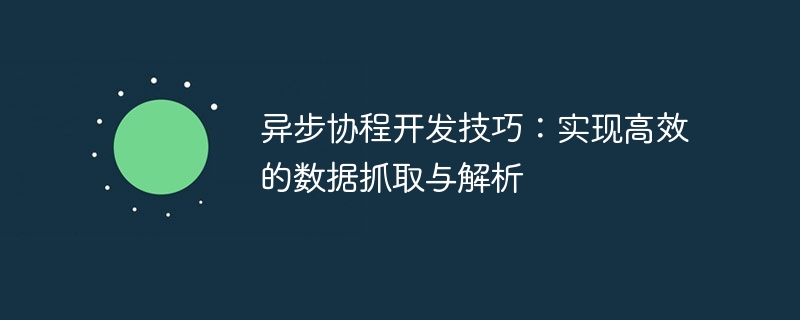Home >Backend Development >PHP Tutorial >Asynchronous coroutine development skills: achieving efficient data capture and analysis
Asynchronous coroutine development skills: achieving efficient data capture and analysis
- WBOYWBOYWBOYWBOYWBOYWBOYWBOYWBOYWBOYWBOYWBOYWBOYWBOriginal
- 2023-12-02 13:57:13624browse

Asynchronous coroutine development skills: achieving efficient data capture and analysis,需要具体代码示例
随着互联网的迅猛发展,数据变得越来越重要,从中获取和解析数据成为许多应用的核心需求。而在数据抓取和解析过程中,提高效率是开发人员面临的重要挑战之一。为了解决这个问题,我们可以利用异步协程开发技巧来实现高效的数据抓取和解析。
异步协程是一种并发编程的技术,它可以在单线程的情况下实现并发执行,避免了线程切换带来的开销,提高了程序的性能。在Python中,我们可以使用asyncio库来实现异步协程。
下面我们以一个小例子来说明如何使用异步协程来实现高效的数据抓取和解析。假设我们要从一个网站上获取一些文章的标题和内容,并将其保存到数据库中。
首先,我们需要安装并导入所需的库。
import asyncio import aiohttp import asyncpg
然后,我们定义一个异步函数来获取文章的标题和内容。
async def fetch_article(url):
async with aiohttp.ClientSession() as session:
async with session.get(url) as response:
if response.status == 200:
data = await response.json()
return data['title'], data['content']接下来,我们定义一个异步函数来保存文章到数据库中。
async def save_article(title, content):
conn = await asyncpg.connect('postgresql://user:password@localhost/db')
await conn.execute('INSERT INTO articles (title, content) VALUES ($1, $2)', title, content)
await conn.close()接着,我们定义一个异步函数来处理每个文章的抓取和保存。
async def process_article(url):
title, content = await fetch_article(url)
await save_article(title, content)最后,我们定义一个主函数来执行所有的异步任务。
async def main():
urls = ['https://example.com/article/1', 'https://example.com/article/2', 'https://example.com/article/3']
tasks = [asyncio.create_task(process_article(url)) for url in urls]
await asyncio.wait(tasks)
asyncio.run(main())通过以上代码,我们可以实现并发地抓取和保存多个文章,大大提高了抓取和解析数据的效率。
总结起来,利用异步协程开发技巧可以实现高效的数据抓取和解析。通过利用asyncio库,我们可以在单线程中实现并发执行,提高程序的性能。在实际开发中,我们可以根据需求来扩展和改进这些技巧,以适应不同的场景,实现更加高效的数据处理。
(注:以上代码仅供参考,具体实现取决于项目需求和环境配置,请根据具体情况进行修改。)
The above is the detailed content of Asynchronous coroutine development skills: achieving efficient data capture and analysis. For more information, please follow other related articles on the PHP Chinese website!
Related articles
See more- What should I do if a parsing package error is displayed when installing an application?
- Let's talk about how to capture data using Node.js + Cheerio
- Use Gin framework to implement crawler and data scraping functions
- Asynchronous Coroutine Development Guide: Implementing High Concurrency Message Push Function

